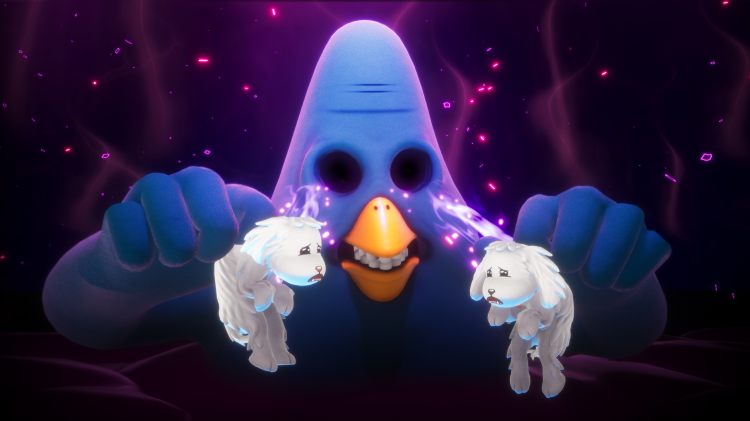Justin Roiland is the co-creator and voice of the stars on the hit animated series Rick and Morty, but he’s also getting serious about the video game business. He started Squanch Games in 2016, and its first title, the virtual reality 3D platformer Trover Saves the Universe, is coming out on May 31 for PlayStation 4 and PC.
But Roiland isn’t just experimenting with VR. Squanch Games has partnered with Snapchat to create some interesting augmented reality content for Trover. This includes using the app to make the game’s cover art come alive. And when playing, you’ll come across a way to unlock a special Snapchat lens that puts the game’s odd power babies into your eyes (I know that sounds weird, but … well, it is weird).
Although Trover supports VR, you don’t need a headset to play it. In the first scene of the game, along with finding that special lens, Snapchat can help unlock some other fun content if you point your phone’s camera at the scene. This implementation of AR is way for Squanch to add extra immersion and fun to the experience even if you’re not playing in VR. You can see how some of this content looks below.
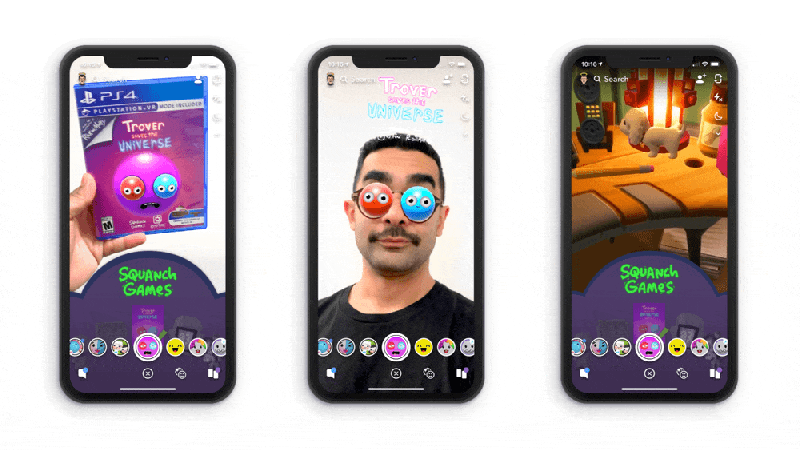
Above: Trover gets some Snapchat fun.
For Snapchat, this is another chance to expand its operations into the lucrative gaming business, as well as work with one of the rising stars in the entertainment world. I talked with Roiland, along with Snapchat’s head of gaming partnerships John Imah, about how this partnership came to be. I also got to ask Roiland about his experience making Trover Saves the Universe.
GamesBeat: Why are you so interested in VR, and now AR?
Justin Roiland: It’s interesting. I’ve been a lifelong gamer. I didn’t even realize how much time I spent gaming until I started putting together Squanch Games as a studio and talking to people. I started to realize, wow, if you were to do a pie graph of my life, at least a quarter of it has been spent playing video games, which is kind of frightening to imagine. What it was, the initial experience of going into VR, especially room-scale VR, it just blew my mind open. In between seasons two and three of Rick and Morty — or I think it was between seasons three and four. And two and three. Both of them. I was just completely entrenched in VR. I had the dev kit, the early Vive.
I was playing everything I could get my hands on. I was meeting as many developers as I could meet. I was designing as many games as I could design on paper. Writing stories and coming up with mechanics. Everything I could do up to literally coding shit, because I’m not an engineer. I think it’s just the incredible immersive experience of putting a player in a world. What I wanted to see was players in worlds where they’re meeting characters, really interesting characters. There wasn’t a lot of that in the early days of VR. We’re getting more of it now, thank God, but still there’s not a ton of games with really strong characters that are there, right there in your face hanging out with you or going on an adventure with you. That, to me, was what was missing, and that was what I wanted to bring to the medium.
But then, throughout the process of making Trover, I had this insane epiphany. I don’t know why it didn’t hit me before. I think it was because I had a full team, an amazing team of artists and programmers and designers and stuff, and we’d built the studio. I just had this epiphany that, holy shit, we don’t just need to make VR and AR. We can make video games. I could actually make a video game in general with this amazing team. So now — we’re super focused and excited about having one of our feet in VR and AR and future emerging technologies. That’s very much at the heart of the studio. But we obviously, with Trover — we realized how fun the game was just on the TV. We started porting it over really early on. A lot of the devs, for iteration purposes, were playing levels on their monitors, not in VR. We thought, oh, this looks pretty good. It plays pretty good. It’s a unique game on the TV. It’s not the kind of thing you would ever think to design right out of the box, sitting down on page one, let’s design it like this. It was very much VR, but then as a result, it turns out it’s a really unique concept design-wise for traditional TVs. The game plays incredibly just on the TV.
I think the Snapchat stuff is going to be, by and large — most people who will be playing it on the TV by themselves, that’s how they’ll access the Snapchat stuff. Not so much in VR. Some players, I can imagine having a friend over, so one is in VR and the other is sitting with their phone open with Snapchat and they’re telling their friend, hey, look at this thing in the room, look at whatever object, and then VR player will look at it and the person who’s not in VR will go to the TV, mirroring what their friend is seeing, and they’ll access the content on Snapchat. But I think by and large people will be experiencing the game with the Snapchat filters in the traditional TV mode, not the VR mode. That’s a long-winded answer as to why — I guess more I’m answering the question of why I got into game development. It was definitely that VR blew my mind open, and then having this amazing team and this epiphany that we could make video games. Now we’re very excited about the future of Squanch. Doing both of those, doing really cool VR things and doing really cool new stuff, new regular video games.
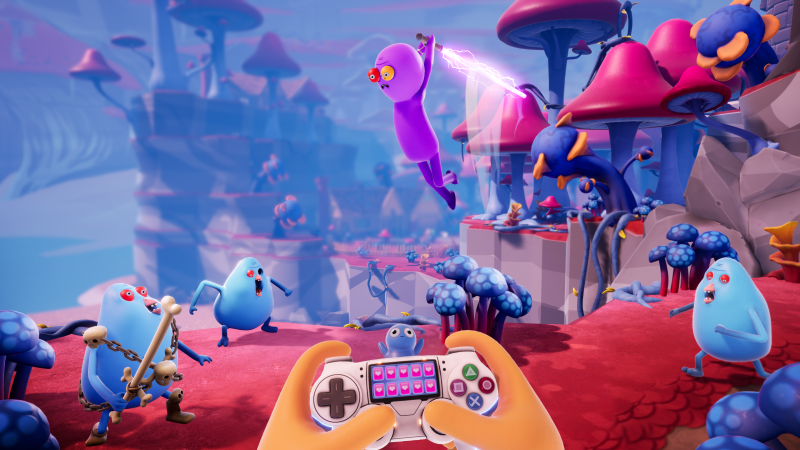
Above: You need a laser sword if you’re going to save the universe.
GamesBeat: Why are you excited about this partnership?
Roiland: The ability for players to use Snapchat literally in concert with the game, to unlock a bunch of — it’s almost like commentary. It’s like a director’s commentary. You’re using your phone as you’re playing the game in this particular location, and you can scan certain objects that are on the TV screen in the game, and it’ll activate an AR component on Snapchat with interesting tidbits and info about different things in the game, which is really cool. It’s definitely something that I haven’t seen done before. The team got really excited about it. We’d love to do more of that kind of stuff in the future. It’s such a neat way to add another layer to a video game. So many other media have commentary tracks or other ways to look at the content. This was such an interesting, easy, and fun way, an interactive way to bring that to the game. In addition to the filter it unlocks, and then also all the cool AR stuff when you point it at the game. It’s this whole interactive experience in the game with Snapchat. It’s really cool. It’s exciting to see what else is going to happen in the future.
John Imah: For us, as we look at the future of gaming, we want to be innovative in the space. But the nice thing about this partnership is this is really the first of its kind, that shows the power of Snap’s AR experience, as well as its ability to creatively engage players in a new, compelling way. Which, for us, is very important, as embark down this journey of working with game developers and creators. We want to make sure we understand the market, and we’re also being innovative and creating cool experiences. To give a little background in terms of Snapchat, on average 70 percent of Snap’s daily active users play with or view lenses. It’s a big thing. You’ve probably seen a lot of the viral lenses that have gotten big, like the baby lens or the gender-swap lens. This plays to the core strengths of Snapchat.
We’ve made a few announcements in the last few months. We announced Bitmoji for games, the SDK, as well as the Snap games platform, the HTML5 realtime multiplayer game. Now we’re expanding that into these partnerships, whether it’s through AR or content. It’s an exciting time for us to build this gaming ecosystem on Snapchat and show users or partners, whether you’re a game company, the power of Snapchat and what you can do. We also have this product called Lens Studio where you can create these same experiences like we did for Justin and his team. Anyone can use that as long as they have the artwork and bring these experiences to life.
Roiland: The thing that’s so cool — as a lifelong gamer, I’d love to see a lot more of this in other games. I love the idea of opening Snap and being able to point it at things in the game and unlock some cool information, behind the scenes stuff, or even just more jokes or funny moments, or a filter. It hits that sweet spot in the gamer’s brain, at least for me, speaking for myself. I love the idea of that extra layer of exploring the game, outside of the game almost, in a completely different way.
GamesBeat: The game really encourages players to linger after scenes seem to be done. This AR stuff continues that trend, giving people a reason to scour for other hidden jokes. Why is that something you like to encourage in the game?
Roiland: It all dials into surprising the player. I love when I play a video game and I do something and then I’m met with some kind of response I wasn’t expecting. I realize in that moment, oh, the developer knew I was going to try to do this thing that I’m not supposed to do, or that I wouldn’t imagine would think to do, and they thought of it already and put something in there to surprise me. I love that stuff so much. That was kind of one of the major driving forces all throughout Trover. Every time we would playtest, every time we would watch different people play, we would always notice if they did something we weren’t expecting anybody to do. We would take note of that and then go in and put something in, either a line of dialogue or something to surprise the player. Oh, yeah, we knew you might try to do this, so we prepped for it. That kind of philosophy and energy is definitely akin to the same desire to do the Snapchat thing. When you find out about it you’ll think, whoa, you mean I can go back into this first part of the game and I can hang out and just scan objects in the room? You’ll be trying to figure out, okay, what are all the objects? It’s one of those fun bonus gamer things that you wouldn’t expect to find, but when you do it’s going to feel really special.
Imah: One thing that’s also exciting for me is, as a fellow gamer my whole life, I love to collect stuff, and I love stuff to do. On the box art side, the thing that’s interesting to me — you think about gaming versus any other vertical in the world right now, gaming still resonates, to where gamers actually want to go to the store and buy a physical copy, or whatever the merchandise is, in this case the game. To be able to have that and be able to do something with the box art and have it come to life extends that. On the create side, as you’re in the game and finding these clues and such, you can also share that experience. Everyone’s doing that these days. They want to extend the life of what they’re doing, whether it’s watching a TV show or playing a game. When you put together those experiences, we’re creating something special that not only extends the life of the game, but also gets gamers continuously talking and sharing this experience with their friends and family.
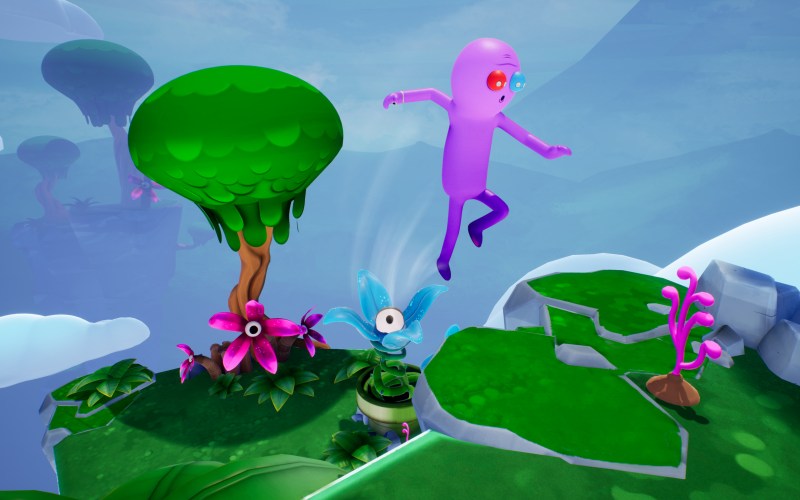
Above: You need power babies to be powerful.
GamesBeat: The Snapchat filter puts those eyehole babies on your face, which is a big part of the game. How did you come up with the concept of these power babies?
Roiland: [Laughs] That was an early, early idea. When I was initially brainstorming all these different concepts for video games, I’d created a character that was originally a bad guy in a different concept, completely different game idea. They were called eyehole monsters. They were going to be the enemies in the game. You would be able to tell what kind of powers they had based on the color of the little creatures inside their eyeholes. They were very much — it was very much like, oh, this one has two green eyes, two green power babies plugged into his eyes, that means he shoots poisonous goo at me or whatever it is. It was a very game design-ey concept from the early days. As I began to iterate and think more about what we were going to actually make for the first game, what’s the best thing for us to make, what’s the thing I’m most excited about to start first — it started to pivot.
What I really found I enjoyed in VR at that time, and I still do actually prefer it, is the seated gamepad VR experiences. Room scale is incredible and I’ve played hours of room scale VR. But playing really good seated VR where I’m transported into another world and I’m controlling a third-person character in that world, that was really compelling. The first character I thought of to include in that was one of these little eyehole monster characters I had come up with. Then I was thinking about upgrades. It would be so cool if — Trover is a parasitic alien. He has kind of a symbiotic relationship with these little power babies. When he plugs them in, they have an effect on him. They’re pretty happy to be plugged into his eyes. He’s one of the good parasitic-based eyehole monsters out there. [laughs] It’s insane.
I think I’m just insane, I guess, is the short answer. I don’t know where this stuff comes from. But what’s cool, the game, the physical copy that Gearbox published with us, if you take the art out, the insert, the cover, you can flip it around and the very first drawing of Trover I ever did is on the other side as a little bonus. It’s literally two pages from my sketchbook, from way back when I was first trying to figure out how this game would work with Trover. You can see what he looked like in the very early days, from my original drawings.
GamesBeat: There’s a lot of dialogue in the game, and even now there’s some in this Snapchat stuff. Is it a different experience for you to record dialogue for this game instead of for your show?
Roiland: It’s similar to how we would do [Rick and Morty episode] Interdimensional Cable. A lot of it is that way, where it’s like — first of all, it’s very important to us as a studio, especially to me, that we never force the player to have to sit and listen to too much. We do a good job of making sure the player has the option to keep playing. If they want to just keep going and not have to sit and listen, they can. I really appreciate that in games. I find myself hanging back and listening a lot of the time when I’m playing. I want to soak it all in. It depends on what the game is and how the writing is. But it’s optional, as much as we could possibly make it optional. If you want to hang back you can listen to a whole five-minute scene that’s ridiculous and hilarious, but if you’re not into that and you want to keep the game moving, you can do that too. The way we did it was, obviously I spent a lot of time breaking down the story, the larger story. Really paid close attention to that, how convoluted, how complex, how many twists and turns, at what point they happen, all that stuff.
I worked with Erik Wolpaw and Jay Pinkerton, the guys who wrote Portal, in the early days of breaking the story. Once the story was pinned down, then it was just going in and doing a rough script, really rough script. Not the final dialogue, just placeholder, just rough, and not even really — there was a lot of “I’ll get to this later” moments. A video game script is like a phonebook. It’s very big. We just plotted it out. Then we got into the micro and started focusing on the level to level. We knew the macro. We knew where Trover needed to be emotionally at any given point in the game. We knew what the larger picture was, where you were narratively. Just focusing in on the micro. That’s when we had a lot of fun. That’s when it was like, okay, I’d have Erik, the studio’s designer, our lead designer at the studio, he would come over — my buddy Spencer [McCurnin] worked as a writer on the game. Spencer would write a bunch of stuff. We would go into the studio and I would go through Spencer’s stuff, read some of his stuff, and then I would make up a fuckton of stuff. A lot of it is me just riffing. One of the weirdest things about the process was, I never intended to do as many voices as I ended up doing in the game.
I had always intended to cast every character other than Trover, with the exception of a couple. I was like, I’ll do this guy, I’ll do this character. But for the most part it was supposed to be a bunch of — I had all these friends I wanted to cast, and I still did cast a lot of people besides myself. It’s not all just me. But what kept happening was, we’d go in and temp for just a blockout of the level, and I would just record this ridiculous temp, thinking in my head, well, we’ll replace this later. I’d be really loose and stupid and not really give a shit. I’m doing it in a way where I don’t give a shit about it. Whatever, who cares, we’re gonna replace it. And then we get down the road and we have it up on its feet and we’re playing it, and it’s really funny. It’s working really well. One thing I can say about game development is there are so many fires to put out, so much shit to do that isn’t working and isn’t going well, that when you have something that’s working and going well, the last thing you want to do is fuck with it. That just kept happening. We’re like, OK, this temp that we have is working. It’s funny. It’s serving all the beats we need. It’s ridiculous. It’s tonally different than anything we’ve ever seen in a video game. Let’s just leave it and keep moving. We have other shit to do. We have a lot of work to do.
That kept happening with a bunch of different characters. That’s why there’s so much of me in the game. But yeah, it was a lot of improv. It was a lot of having fun, getting drunk and recording. To be completely honest with you, we would do — we didn’t do that for the whole game, but there’s definitely recording where I would sit there and sip whatever, wine or a vodka and soda, and we’d have a six-hour record. There’s a level in the game where you can hear me get drunker and drunker, and we just left it all in. It’s fucking amazing.
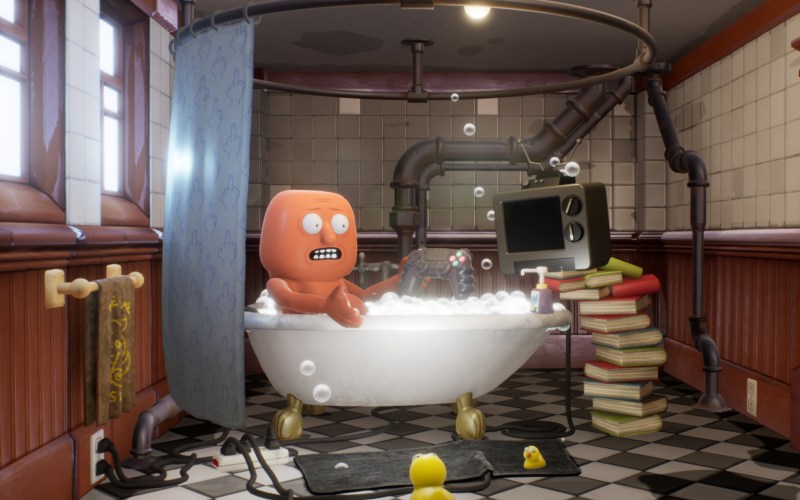
Above: Oops.
GamesBeat: What’s it like to be so close to the release of the game now?
Roiland: It’s both a relief and also kind of terrifying. I’ve sent codes to a lot of people that are close to me, friends and peers I respect. I’ve heard nothing but absolute elated excitement and positive reactions to the game. Everybody I’ve sent codes to — [The Walking Dead creator] Robert Kirkman is a good friend of mine. He was one of the first people to get through the game. He wrote me this incredible email, this incredibly heartfelt, honest, over the moon excitement about the game. He couldn’t say enough nice things. Jack Black is another person I sent code to who just flipped out about it. Countless people that I got codes to early on that got into the game and played and just really loved it. That helped ease my nerves a little bit.
Obviously the biggest thing you’re worried about is, what are critics going to think? What is the world at large going to think? Is it any good? We’re so close to it, the whole team at this point. But I feel better about that stuff just based on all the responses I’ve gotten from a lot of people. And then now it’s just, is it going to sell well? Are we going to — is the word going to get out there? Are people going to know it exists? Are we going to sell enough copies? That kind of stuff. It’s an interesting place, an interesting time.
Imah: We’re excited to be a part of this journey with Justin and the team, to see how players react to the game, as well as the partnership that’s been collaborated on by Snapchat and Squanch Games. It’s an exciting time. We’re excited to see how this all pans out when it launches.
Roiland: One thing I’m the most excited about, honestly, is going into a GameStop and seeing the game on the shelf and getting the Snapchat filter out and recording some stuff and posting it. That’s going to be so cool. I’m literally going to be doing that on the 31st of the month, just going in and doing that. I’m super excited. That kind of stuff, it’s so neat we have that. The Snapchat thing is so frickin’ cool.
